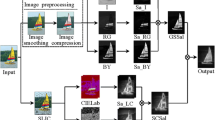Abstract
Visual saliency is an important cue in human visual system to detect salient objects in natural scenes. It has attracted a lot of research focus in computer vision, and has been widely used in many applications including image retrieval, object recognition, image segmentation, and etc. However, the accuracy of salient object detection model remains a challenge. Accordingly, a hierarchical salient object detection model is presented in this paper. In order to accurately interpret object saliency in image, we propose to investigate distinctive features from a global perspective. Image contrast and color distribution are calculated to generate saliency maps respectively, which are then fused using the principal component analysis. Compared with state-of-the-art models, the proposed model can accurately detect the salient object which conform with the human visual principle. The experimental results from the MSRA database validate the effectiveness of our proposed model.





Similar content being viewed by others
References
Achanta R, Estrada F, Wils P, Susstrunk S (2008) Salient region detection and segmentation. In: The 6th International conference on computer vision systems, pp 66–75
Achanta R, Susstrunk S (2010) Saliency detection using maximum symmetric surround. In: The IEEE International conference on image processing, pp 2653–2656
Aziz MZ, Mertsching B (2008) Fast and robust generation of feature maps for region-based visual attention. IEEE Trans Image Process 17:633–644
Borji A, Itti L (2012) Exploiting local and global patch rarities for saliency detection. In: IEEE conference on computer vision and pattern recognition, pp 478–485
Chen LQ, Xie X, Fan X, Ma WY, Zhang HJ, Zhou HQ (2003) A visual attention model for adapting images on small displays. Multimedia Systems 9:353–364
Cheng MM, Zhang GX, Mitra NJ, Huang X, Hu SM (2011) Global contrast based salient region detection. In: IEEE conference on computer vision and pattern recognition, pp 409–416
Duan L, Wu C, Miao J, Qing L, Fu Y (2011) Visual saliency detection by spatially weighted dissimilarity. In: IEEE conference on computer vision and pattern recognition, pp 473–480
Harel J, Koch C, Perona P (2007) Graph-based visual saliency. In: Advances in neural information processing systems, pp 545–552
Hou X, Harel J, Koch C (2012) Image signature: highlighting sparse salient regions. IEEE Trans Pattern Anal Mach Intell 34:194–201
Itti L, Koch C, Niebur E (1998) A model of saliency based visual attention for rapid scene analysis. IEEE Trans Pattern Anal Mach Intell 20:1254–1259
Judd T, Ehinger K, Durand F, Torralba A (2009) Learning to predict where humans look. In: The IEEE International conference on computer vision, pp 2106–2113
Koch C, Ullman S (1985) Shifts in selective visual attention: towards the underlying neural circuitry. Hum Neurobiol 4:219–227
Liu T, Sun J, Zheng NN, Tang X, Shum HY (2007) Learning to detect a salient object. In: IEEE conference on computer vision and pattern recognition, pp 1–8
Lu Y, Zhang W, Lu H, Xue X (2011) Salient object detection using concavity context. In: IEEE International conference on computer vision, pp 233–240
Murray N, Vanrell M, Otazu X, Parraga CA (2011) Saliency estimation using a non-parametric low-level vision model. In: IEEE conference on computer vision and pattern recognition, pp 433–440
Santella A, Agrawala M, DeCarlo D, Salesin D, Cohen M (2006) Gaze-based interaction for semi-automatic photo cropping. In: Proceedings of SIGCHI conference on human factors in computing systems, pp 771–780
Shi K, Wang K, Lu J, Lin L (2013) PISA: Pixelwise image saliency by aggregating complementary appearance contrast measures with spatial priors. In: IEEE conference on computer vision and pattern recognition, pp 2115–2122
Stas G, Lihi ZM, Ayellet T (2012) Context-aware saliency detection. IEEE Trans Pattern Anal Mach Intell 34:1915–1926
Stentiford F (2007) Attention based auto image cropping. In: ICVS workshop on computational attention and application, pp 1–9
Treisman A, Gelade G (1980) A feature-integration theory of attention. Cogn Psychol 12:97–136
Vu CT, Chandler DM (2012) S3: A Spectral and spatial measure of local perceived sharpness in natural images. IEEE Trans Image Process 21:934–945
Zhang L, Tong MH, Marks TK, Shan H, Cottrell GW (2008) SUN: a Bayesian framework for saliency using natural statistics. J Vis 8:1–20
Acknowledgments
This work was supported in part by the National Natural Science Foundation of China (61440016, 61375017, 61273225), the Natural Science Foundation of Hubei Provincial of China (2014CFB247), the open foundation of the key laboratory for metallurgical equipment and control of ministry of education (2013B08)
Author information
Authors and Affiliations
Corresponding author
Rights and permissions
About this article
Cite this article
Xu, X., Mu, N., Chen, L. et al. Hierarchical salient object detection model using contrast-based saliency and color spatial distribution. Multimed Tools Appl 75, 2667–2679 (2016). https://doi.org/10.1007/s11042-015-2570-0
Received:
Revised:
Accepted:
Published:
Issue Date:
DOI: https://doi.org/10.1007/s11042-015-2570-0




